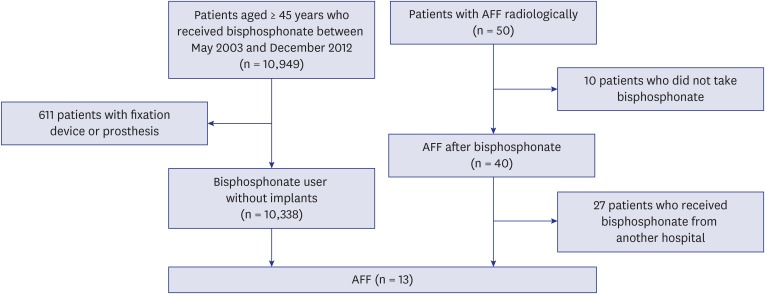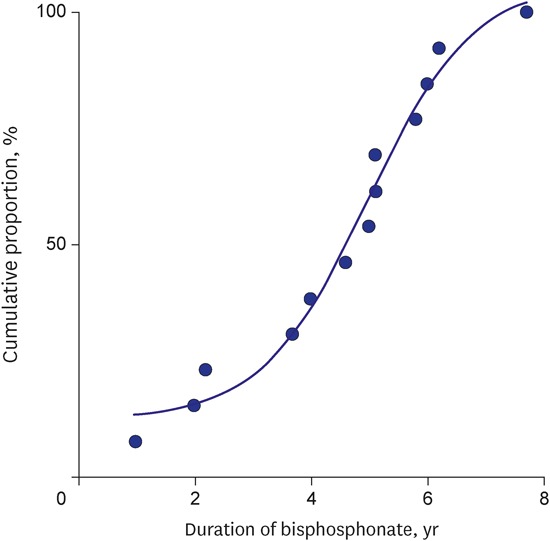1. Shane E, Burr D, Abrahamsen B, Adler RA, Brown TD, Cheung AM, et al. Atypical subtrochanteric and diaphyseal femoral fractures: second report of a task force of the American Society for Bone and Mineral Research. J Bone Miner Res. 2014; 29(1):1–23. PMID:
23712442.

2. Park-Wyllie LY, Mamdani MM, Juurlink DN, Hawker GA, Gunraj N, Austin PC, et al. Bisphosphonate use and the risk of subtrochanteric or femoral shaft fractures in older women. JAMA. 2011; 305(8):783–789. PMID:
21343577.

3. Lee YK, Ha YC, Park C, Yoo JJ, Shin CS, Koo KH. Bisphosphonate use and increased incidence of subtrochanteric fracture in South Korea: results from the National Claim Registry. Osteoporos Int. 2013; 24(2):707–711. PMID:
22618268.

4. Dell RM, Adams AL, Greene DF, Funahashi TT, Silverman SL, Eisemon EO, et al. Incidence of atypical nontraumatic diaphyseal fractures of the femur. J Bone Miner Res. 2012; 27(12):2544–2550. PMID:
22836783.

5. Teo BJ, Koh JS, Goh SK, Png MA, Chua DT, Howe TS. Post-operative outcomes of atypical femoral subtrochanteric fracture in patients on bisphosphonate therapy. Bone Joint J. 2014; 96-B(5):658–664. PMID:
24788502.

6. Edwards BJ, Bunta AD, Lane J, Odvina C, Rao DS, Raisch DW, et al. Bisphosphonates and nonhealing femoral fractures: analysis of the FDA Adverse Event Reporting System (FAERS) and international safety efforts: a systematic review from the Research on Adverse Drug Events And Reports (RADAR) project. J Bone Joint Surg Am. 2013; 95(4):297–307. PMID:
23426763.
7. Goh SK, Yang KY, Koh JS, Wong MK, Chua SY, Chua DT, et al. Subtrochanteric insufficiency fractures in patients on alendronate therapy: a caution. J Bone Joint Surg Br. 2007; 89(3):349–353. PMID:
17356148.
8. Abrahamsen B, Eiken P, Eastell R. Cumulative alendronate dose and the long-term absolute risk of subtrochanteric and diaphyseal femur fractures: a register-based national cohort analysis. J Clin Endocrinol Metab. 2010; 95(12):5258–5265. PMID:
20843943.

9. Wang Z, Ward MM, Chan L, Bhattacharyya T. Adherence to oral bisphosphonates and the risk of subtrochanteric and femoral shaft fractures among female medicare beneficiaries. Osteoporos Int. 2014; 25(8):2109–2116. PMID:
24846316.

10. Kim SY, Schneeweiss S, Katz JN, Levin R, Solomon DH. Oral bisphosphonates and risk of subtrochanteric or diaphyseal femur fractures in a population-based cohort. J Bone Miner Res. 2011; 26(5):993–1001. PMID:
21542002.

11. Ha YC, Kim TY, Lee A, Lee YK, Kim HY, Kim JH, et al. Current trends and future projections of hip fracture in South Korea using nationwide claims data. Osteoporos Int. 2016; 27(8):2603–2609. PMID:
27112763.

12. Kim TY, Jang S, Park CM, Lee A, Lee YK, Kim HY, et al. Trends of incidence, mortality, and future projection of spinal fractures in Korea using nationwide claims data. J Korean Med Sci. 2016; 31(5):801–805. PMID:
27134505.

13. Ha YC, Lee YK, Lim YT, Jang SM, Shin CS. Physicians’ attitudes to contemporary issues on osteoporosis management in Korea. J Bone Metab. 2014; 21(2):143–149. PMID:
25006571.

14. Lee YK, Jang S, Ha YC. Management of osteoporosis in South Korea. Crit Rev Eukaryot Gene Expr. 2015; 25(1):33–40. PMID:
25955816.

15. Yoo S, Hwang H, Jheon S. Hospital information systems: experience at the fully digitized Seoul National University Bundang Hospital. J Thorac Dis. 2016; 8(Suppl 8):S637–S641. PMID:
27651940.

16. Lo JC, Huang SY, Lee GA, Khandelwal S, Provus J, Ettinger B, et al. Clinical correlates of atypical femoral fracture. Bone. 2012; 51(1):181–184. PMID:
22414379.

17. Fay MP, Feuer EJ. Confidence intervals for directly standardized rates: a method based on the gamma distribution. Stat Med. 1997; 16(7):791–801. PMID:
9131766.

18. Powell D, Bowler C, Roberts T, Garton M, Matthews C, McCall I, et al. Incidence of serious side effects with intravenous bisphosphonate: a clinical audit. QJM. 2012; 105(10):965–971. PMID:
22753670.

19. La Rocca Vieira R, Rosenberg ZS, Allison MB, Im SA, Babb J, Peck V. Frequency of incomplete atypical femoral fractures in asymptomatic patients on long-term bisphosphonate therapy. AJR Am J Roentgenol. 2012; 198(5):1144–1151. PMID:
22528906.

20. Tamminen IS, Yli-Kyyny T, Isaksson H, Turunen MJ, Tong X, Jurvelin JS, et al. Incidence and bone biopsy findings of atypical femoral fractures. J Bone Miner Metab. 2013; 31(5):585–594. PMID:
23553501.

21. Schilcher J, Aspenberg P. Incidence of stress fractures of the femoral shaft in women treated with bisphosphonate. Acta Orthop. 2009; 80(4):413–415. PMID:
19568963.

22. Puhaindran ME, Farooki A, Steensma MR, Hameed M, Healey JH, Boland PJ. Atypical subtrochanteric femoral fractures in patients with skeletal malignant involvement treated with intravenous bisphosphonates. J Bone Joint Surg Am. 2011; 93(13):1235–1242. PMID:
21776577.

23. Ernat J, Song D, Fazio M, Lindell K, Orchowski J. Radiographic changes and fracture in patients having received bisphosphonate therapy for ≥ 5 years at a single institution. Mil Med. 2015; 180(12):1214–1218. PMID:
26633664.
24. Chang ST, Tenforde AS, Grimsrud CD, O’Ryan FS, Gonzalez JR, Baer DM, et al. Atypical femur fractures among breast cancer and multiple myeloma patients receiving intravenous bisphosphonate therapy. Bone. 2012; 51(3):524–527. PMID:
22634175.

25. Allison MB, Markman L, Rosenberg Z, Vieira RL, Babb J, Tejwani N, et al. Atypical incomplete femoral fractures in asymptomatic patients on long term bisphosphonate therapy. Bone. 2013; 55(1):113–118. PMID:
23567160.
26. Schilcher J, Koeppen V, Ranstam J, Skripitz R, Michaëlsson K, Aspenberg P. Atypical femoral fractures are a separate entity, characterized by highly specific radiographic features. A comparison of 59 cases and 218 controls. Bone. 2013; 52(1):389–392. PMID:
23098829.

27. Marcano A, Taormina D, Egol KA, Peck V, Tejwani NC. Are race and sex associated with the occurrence of atypical femoral fractures? Clin Orthop Relat Res. 2014; 472(3):1020–1027. PMID:
24166075.

28. Chen LP, Chang TK, Huang TY, Kwok TG, Lu YC. The correlation between lateral bowing angle of the femur and the location of atypical femur fractures. Calcif Tissue Int. 2014; 95(3):240–247. PMID:
24980895.

29. Hagen JE, Miller AN, Ott SM, Gardner M, Morshed S, Jeray K, et al. Association of atypical femoral fractures with bisphosphonate use by patients with varus hip geometry. J Bone Joint Surg Am. 2014; 96(22):1905–1909. PMID:
25410509.

30. Soh HH, Chua IT, Kwek EB. Atypical fractures of the femur: effect of anterolateral bowing of the femur on fracture location. Arch Orthop Trauma Surg. 2015; 135(11):1485–1490. PMID:
26286640.

31. Meling T, Nawab A, Harboe K, Fosse L. Atypical femoral fractures in elderly women: a fracture registry-based cohort study. Bone Joint J. 2014; 96-B(8):1035–1040. PMID:
25086118.
32. Schilcher J, Michaëlsson K, Aspenberg P. Bisphosphonate use and atypical fractures of the femoral shaft. N Engl J Med. 2011; 364(18):1728–1737. PMID:
21542743.

33. McClung M, Harris ST, Miller PD, Bauer DC, Davison KS, Dian L, et al. Bisphosphonate therapy for osteoporosis: benefits, risks, and drug holiday. Am J Med. 2013; 126(1):13–20. PMID:
23177553.

34. Watts NB, Diab DL. Long-term use of bisphosphonates in osteoporosis. J Clin Endocrinol Metab. 2010; 95(4):1555–1565. PMID:
20173017.

35. Unnanuntana A, Saleh A, Mensah KA, Kleimeyer JP, Lane JM. Atypical femoral fractures: what do we know about them?: AAOS Exhibit Selection. J Bone Joint Surg Am. 2013; 95(2):e8. PMID:
23324969.
36. Brown JP, Morin S, Leslie W, Papaioannou A, Cheung AM, Davison KS, et al. Bisphosphonates for treatment of osteoporosis: expected benefits, potential harms, and drug holidays. Can Fam Physician. 2014; 60(4):324–333. PMID:
24733321.
37. Reid IR. Efficacy, effectiveness and side effects of medications used to prevent fractures. J Intern Med. 2015; 277(6):690–706. PMID:
25495429.

38. Adler RA, El-Hajj Fuleihan G, Bauer DC, Camacho PM, Clarke BL, Clines GA, et al. Managing osteoporosis in patients on long-term bisphosphonate treatment: report of a Task Force of the American Society for Bone and Mineral Research. J Bone Miner Res. 2016; 31(1):16–35. PMID:
26350171.

39. Lee SH, Gong HS, Kim TH, Park SY, Shin JH, Cho SW, et al. Position statement: drug holiday in osteoporosis treatment with bisphosphonates in South Korea. J Bone Metab. 2015; 22(4):167–174. PMID:
26713307.

40. Im GI, Jeong SH. Pathogenesis, management and prevention of atypical femoral fractures. J Bone Metab. 2015; 22(1):1–8. PMID:
25774358.








 PDF
PDF Citation
Citation Print
Print






 XML Download
XML Download